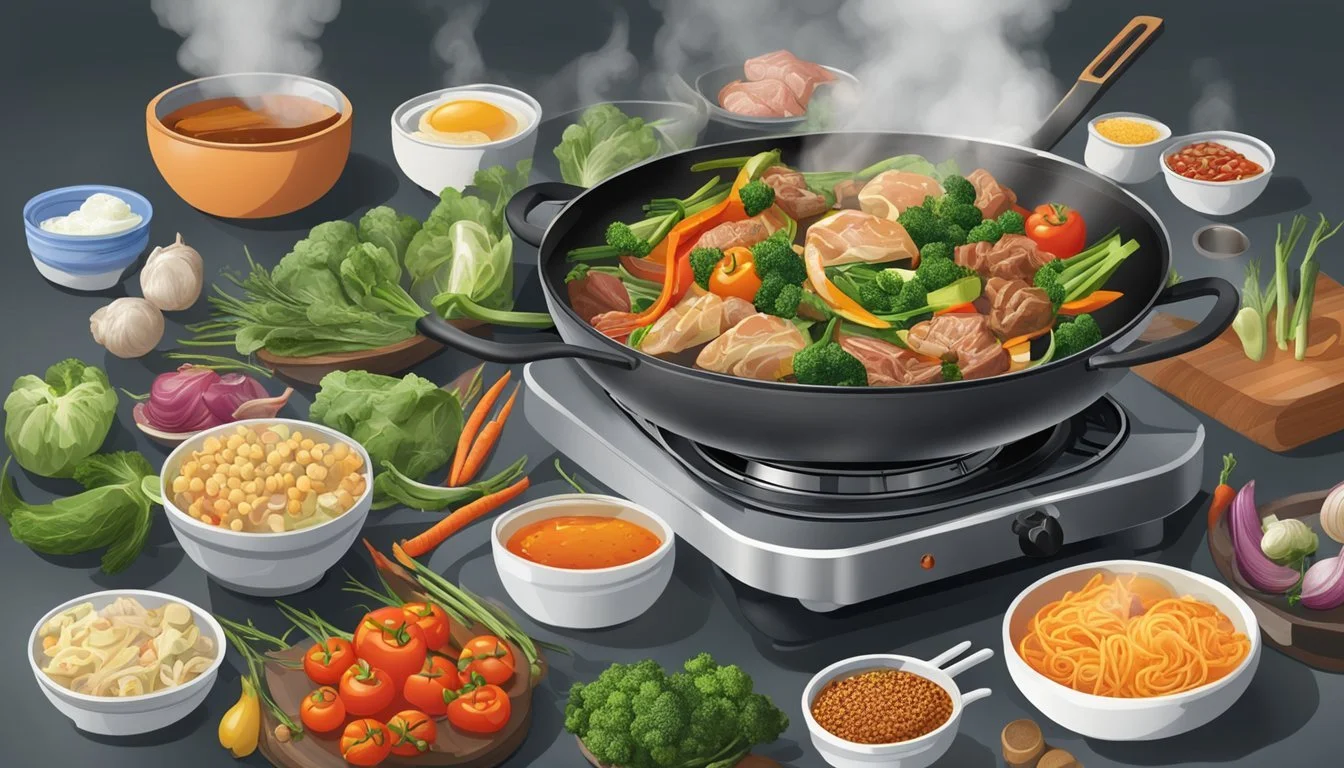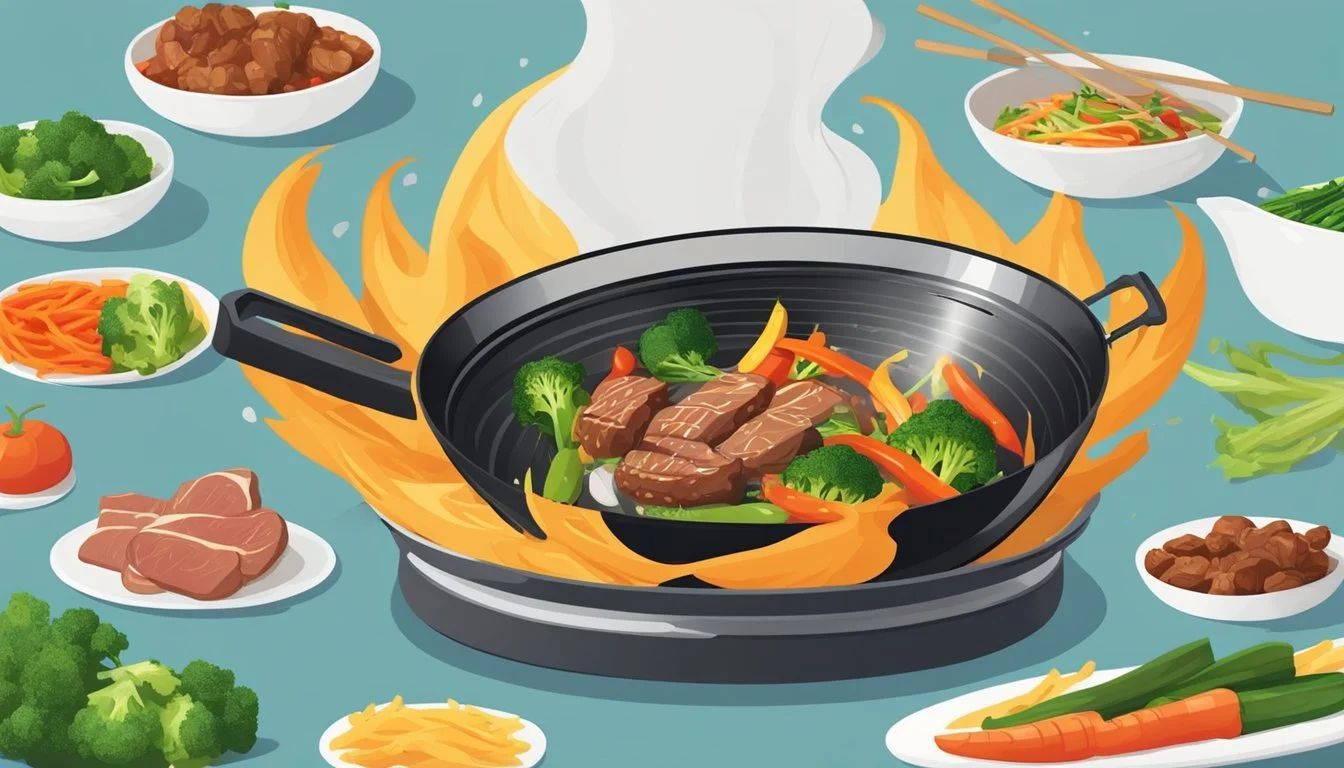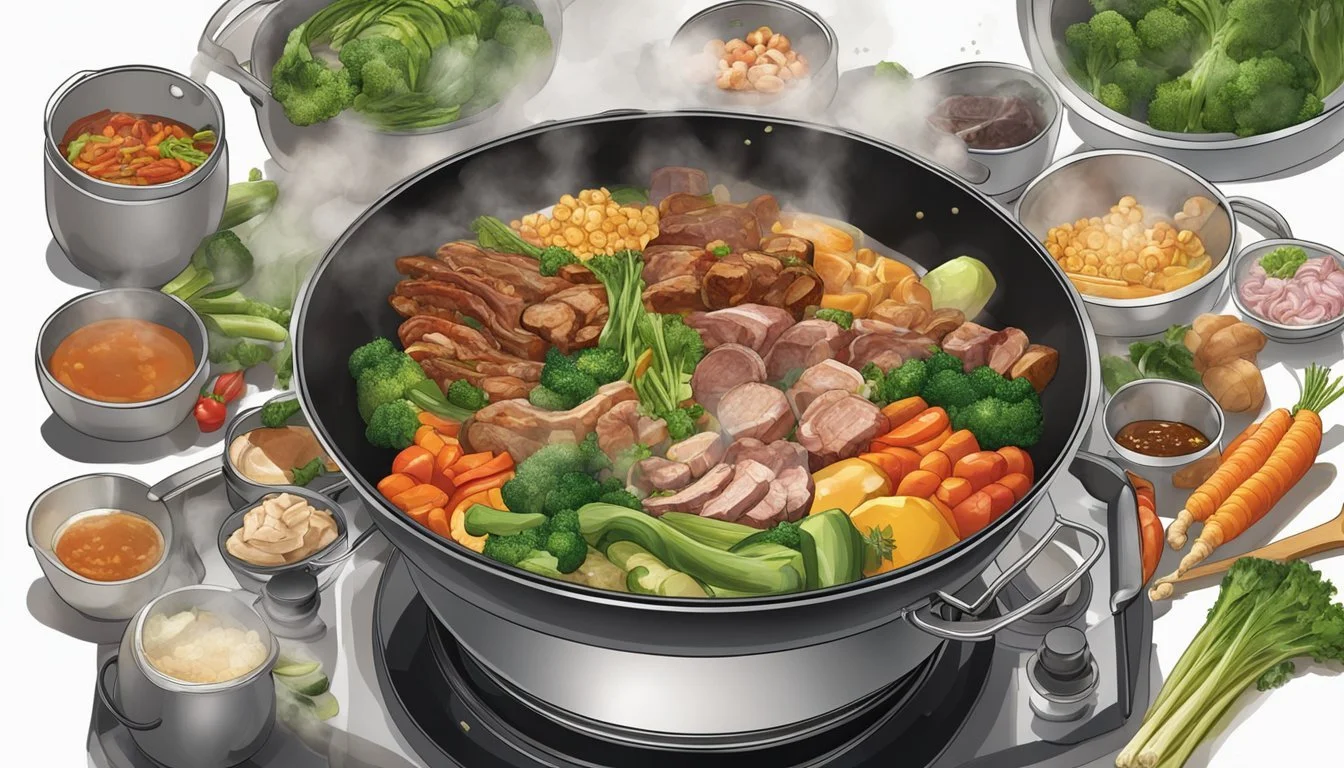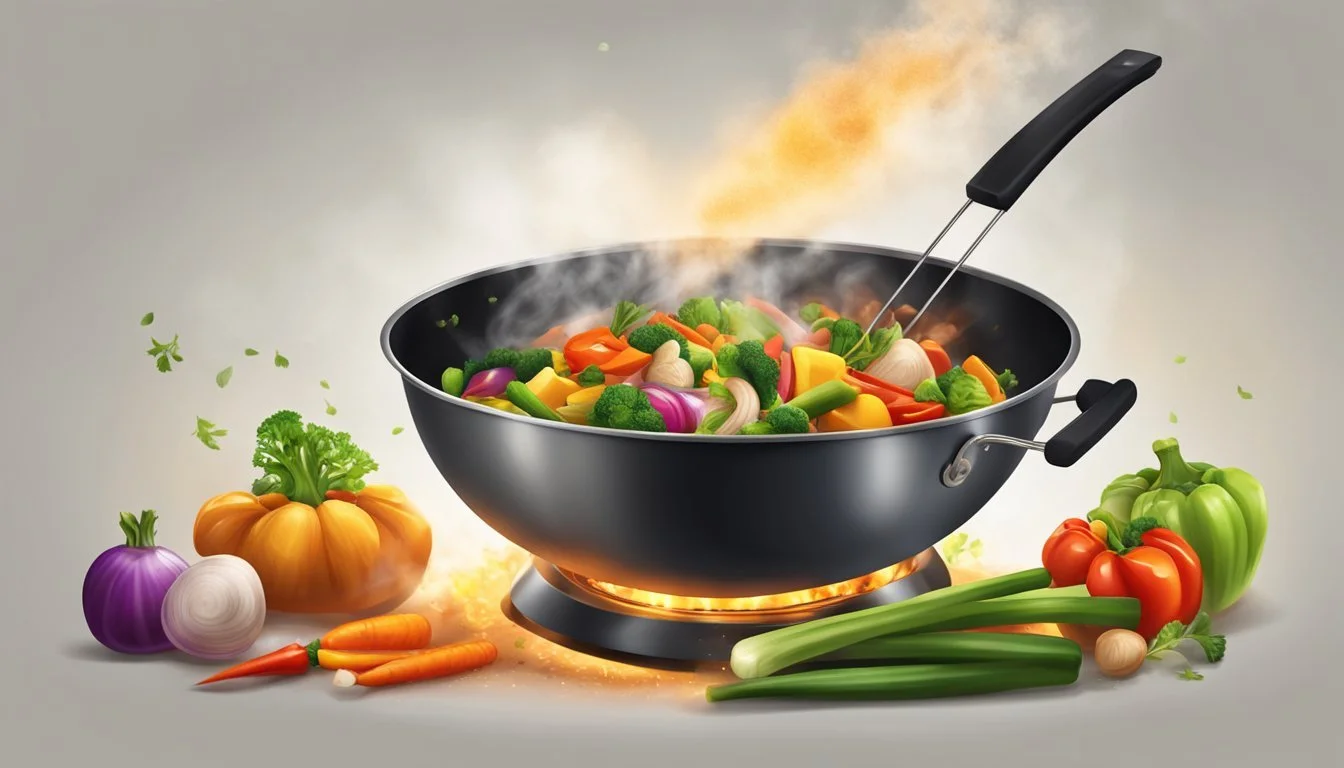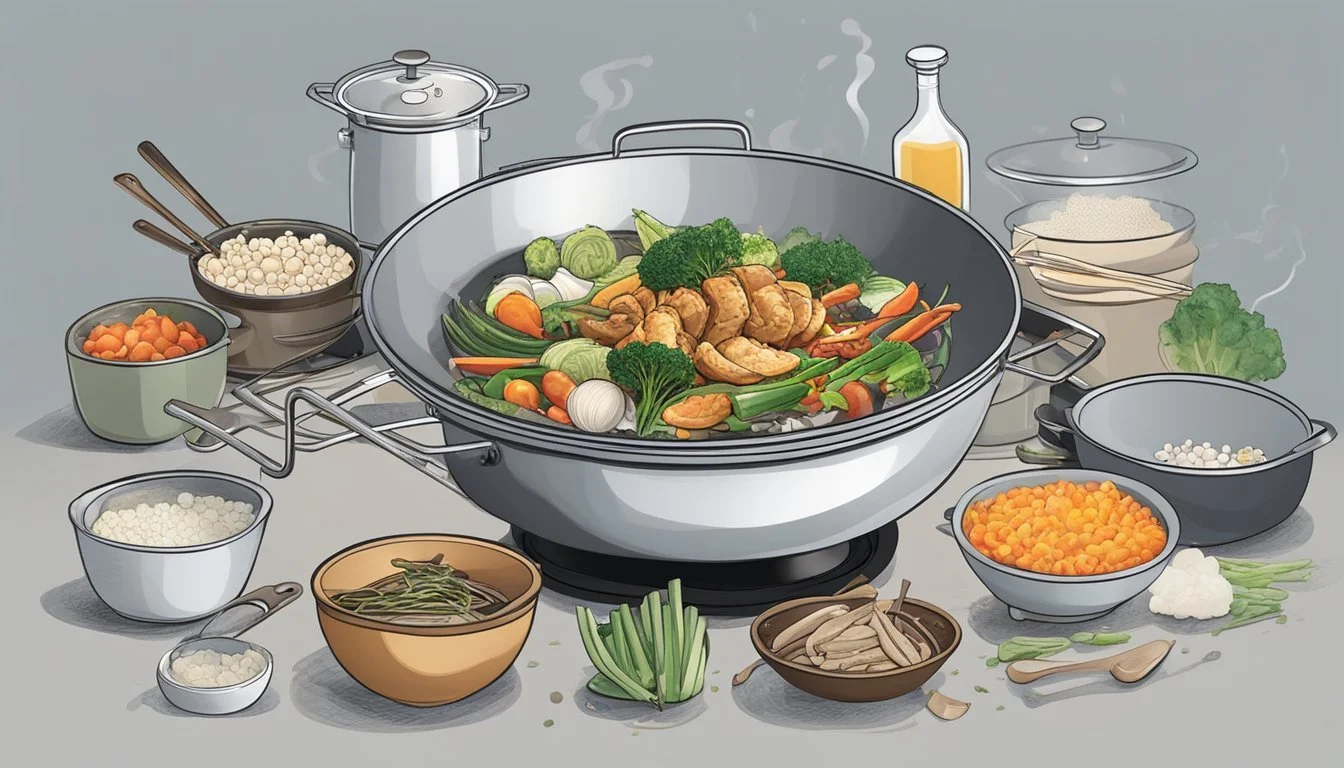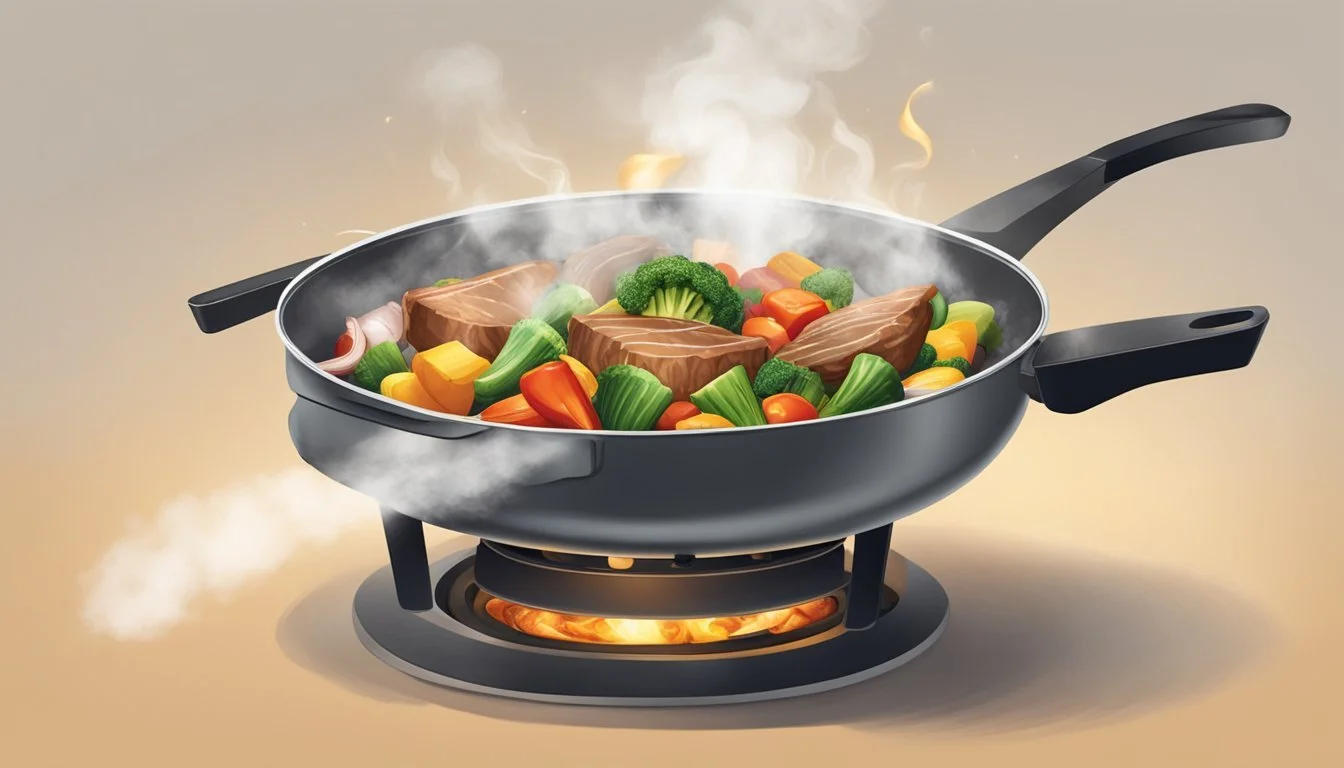How to Use a Wok for Versatile Cooking Beyond Stir-Fry
A wok is often pigeonholed as the vessel of choice for stir-fry, yet its use extends far beyond this single, albeit popular, cooking method. Its unique design makes it incredibly versatile in the kitchen. The high, sloping sides of a wok, for instance, aren't just there for show—they allow chefs to toss and cook ingredients quickly and efficiently, minimizing the risk of spillage while the high heat at the bottom sears food to perfection.
Aside from stir-frying, the wok is an excellent tool for a range of cooking techniques. It can be used for steaming, deep-frying, smoking, and even boiling. The wok's curved interior promotes even heating and allows liquids to concentrate and flavors to meld beautifully, making it ideal for saucy dishes. Moreover, cooks can use a wok for tasks such as toasting spices or nuts, which benefit from the wok's ability to heat up quickly and evenly.
The wok's adaptability stems from the fact that it heats up quickly and retains heat well. Because of this thermal proficiency, it enables the home cook to explore myriad culinary techniques beyond Asian cuisine. With the proper care and some practice, using a wok can elevate one's cooking, turning ordinary ingredients into extraordinary meals.
Choosing the Right Wok
Selecting the appropriate wok is crucial for achieving optimal cooking results beyond just stir-frying. The choice of material and the specific shape and size of a wok can greatly influence its performance in a variety of cooking methods.
Material Considerations
Carbon Steel Woks: They are preferred for their excellent heat conductivity and quick response to temperature changes. A carbon steel wok is typically lighter than cast iron, making it easier to handle. They do require seasoning but, once seasoned, offer a naturally non-stick surface for cooking.
Cast Iron Woks: Heavier and providing consistent heat, cast iron woks excel at retaining temperature. While slower to heat up, they are ideal for recipes requiring steady heat over time. Like their carbon steel counterparts, they also need to be seasoned to enhance their non-stick properties.
Materials like aluminum are also an option, being lightweight, although they do not retain heat as well as carbon steel or cast iron.
Wok Shapes and Sizes
Flat-Bottomed Woks: These are compatible with most Western stoves, including electric and induction cooktops, providing stability and even heat distribution. The flat-bottomed wok is a practical choice for various cooking styles, as it sits securely on the burner.
Round-Bottomed Woks: Traditional and effective for stir-frying when used over a gas stove, the round-bottomed wok allows heat to be distributed quickly and evenly. However, they may require a wok ring to sit properly on most Western ranges.
When sizing a wok, a 14-inch diameter is commonly recommended. This size is ideal for home use, ensuring that the wok can get sufficiently hot for proper cooking without being overly cumbersome.
Essential Wok Tools and Accessories
A wok is a versatile cooking instrument, and equipping it with the right tools can enhance its functionality far beyond stir-frying. Proper accessories can provide added convenience and open up new cooking techniques.
Wok Ring
A wok ring is vital for stabilizing a round-bottom wok on a standard stovetop. It positions the wok securely, ensuring even heat distribution and safety. It's particularly crucial for gas stoves where the grates may not support the wok's shape.
Spatula and Other Utensils
Long-handled spatulas with a curved edge are designed to match the rounded interior of a wok, making it easier to toss and turn food quickly and efficiently. The length protects the cook’s hands from high heat. In addition, a slotted spoon is useful for removing food from oil or sauce, and a thermometer can be essential to monitor oil temperatures for deep-frying.
Spatula: Ideal for stir-frying and tossing ingredients.
Slotted Spoon: Perfect for removing and draining food.
Thermometer: Essential for maintaining the correct cooking temperature.
Lids and Steamers
For steaming and slow cooking, a domed lid is necessary to retain heat and moisture. It should have a heat-resistant handle for safety. A bamboo steamer can be set into a wok for perfect steaming of vegetables, fish, and dumplings, offering a healthy method of cooking.
Lid: Keeps heat and moisture in for braising and steaming.
Bamboo Steamer: Slots into the wok for an efficient steaming process.
The Art of Seasoning Your Wok
Seasoning a wok is crucial to both safeguard its surface and enhance its cooking performance. The process creates a protective patina that provides a naturally nonstick surface.
Creating a Nonstick Patina
To begin the seasoning process, one must clean the wok thoroughly to remove any residues from manufacturing, using soap, hot water, and a scrubbing pad. This is a one-time step before the initial seasoning. Once the wok is dry, the next crucial phase is the development of the nonstick patina. Here’s a detailed step-by-step approach to achieve it:
Heat the Wok: Place the wok on high heat until it's hot enough that a drop of water instantly vaporizes on the surface.
Oil Application: Lower the heat to medium, then carefully apply a thin layer of high-smoke-point oil, such as peanut or canola, to cover the entire cooking surface. This typically requires about a tablespoon of oil.
Even Coating: Use a paper towel held with tongs to rub the oil evenly over the surface, all the way up the sides to the edge of the wok.
Heating the Oil: Maintain the wok on medium heat for about 5 to 10 minutes, watching for the oil to darken. A properly heated wok will begin to form a brownish patina.
Cooling Down: After the patina develops, turn off the heat and allow the wok to cool completely.
Final Wipe: Once cool, use a fresh paper towel to wipe out any excess oil. The wok is now ready for use.
Creating a nonstick patina is not just about convenience; it’s about preparing the wok to be a versatile cooking tool. Regular use and proper care will continue to improve the wok's seasoning, contributing to its longevity and cooking efficiency.
Mastering Wok Hei
Wok Hei, or the "breath of the wok," is the quintessential characteristic of traditional stir-frying, imparting a complex, smoky flavor to dishes. Achieving Wok Hei at home involves high-heat techniques and precise control of wok temperature.
High Heat Techniques
To recreate Wok Hei, one must use a high heat to cook quickly and efficiently. The use of a blowtorch can assist home chefs in obtaining the needed heat, which initiates the Maillard reaction for an authentic charred flavor. For those without a blowtorch, high heat can also be reached on a gas stove by allowing the wok to heat until just smoking before adding cold oil and ingredients.
Peanut oilgreen onions
Sunflower oil
Grapeseed oil
These oils resist burning at high temperatures, which is crucial for maintaining the characteristic flavors without introducing a burnt taste.
Controlling Wok Temperature
Proper control of temperature is as important as the initial blast of high heat. Aromatics such as garlic, ginger, and green onions should be added when the wok is hot but not scorching to avoid burning. One method to modulate the heat is to prepare a small cup of water near the cooking area. This can be used to cool the wok slightly or to add moisture if the dish becomes too dry while stirring.
Temperature Control Tips:
Use water to cool the wok if necessary.
Avoid crowding the wok to ensure each ingredient is exposed to heat evenly.
Remember, the goal is to maintain a hot wok throughout the cooking process for maximum flavor infusion without degrading the aromatics or producing excessive smoke.
Wok Cooking Methods
The wok is a versatile cooking vessel, enabling a range of techniques beyond stir-frying. Mastering these methods can elevate one's culinary skills and expand the variety of dishes that can be prepared using a single kitchen implement.
Stir-Frying
Stir-frying is a quick-cooking process using high heat and continual movement. Meats and vegetables are cut into small pieces for even, rapid cooking. A small amount of oil is used, and ingredients are stirred consistently to prevent burning, providing a dish that is flavorful and has a slightly crisp texture.
Steaming
A wok can be used for steaming by employing a bamboo steamer or a metal rack. Water is brought to a boil in the wok, and food, such as dumplings or vegetables, is placed in the steamer above water level. This allows the food to cook gently through the steam, retaining moisture, nutrients, and flavor.
Smoking
Smoking in a wok involves lining it with foil, adding smoking ingredients like tea leaves and sugar, and placing food on a rack above the materials. The wok is covered, and food smokes over low heat. This technique imparts a subtle smokiness to meats or fish.
Braising
In braising, food is first seared at high heat, then slow-cooked in a small quantity of liquid in the wok. This method tenderizes the ingredients and infuses them with the flavors from the braising liquid, which can include broths, wines, or sauces.
Boiling and Stewing
Woks are well-suited for boiling and stewing due to their shape. For boiling, the wok is filled with water and brought to a boil to cook foods like noodles or vegetables. Stewing involves cooking ingredients at a lower temperature in a flavorful liquid, allowing flavors to meld and meats to become fork-tender over time.
Deep-Frying
Deep-frying in a wok requires filling it with enough oil to submerge food completely. The wide shape of the wok allows for better heat distribution, and its sloping sides help with splatter control. Foods are cooked to a crispy texture and golden color, with the high heat ensuring a quick fry so that items don't absorb excess oil.
Diversifying Ingredients
When using a wok, the array of ingredients one can employ extends beyond traditional stir-fry elements. This section provides guidance on how to incorporate a wide range of proteins, vegetables, and seafood into your wok cooking repertoire.
Proteins
Meat: For meats such as chicken or beef, it's best to cut them into uniform, thin slices to ensure even cooking. Always pre-heat the wok before adding the meat to avoid sticking and to seal in flavor.
Chicken: Marinate beforehand for tender results.
Beef: Quick sear on high heat retains juiciness.
Pork: Slice thinly and cook swiftly to maintain tenderness.
Tofu: Firm or extra-firm tofu works best for maintaining structure in a searing hot wok. Draining and pressing the tofu prior to use removes excess moisture.
Pressing: At least 30 minutes under a weight.
Cooking: Use a non-stick agent to prevent sticking.
Vegetables
Vegetables should be chopped into bite-sized pieces for even cooking. Denser vegetables may require a longer cooking time, whereas leafy greens cook rapidly.
Dense Vegetables: Carrots, broccoli—blanching beforehand can speed up cooking.
Leafy Greens: Spinach, bok choy—they wilt quickly, so add them last.
Seafood and Others
Seafood cooks quickly in a wok and benefits from high-heat exposure to lock in flavors. When working with ingredients like fish, gentle stirring is key to maintaining their delicate texture.
Fish: Cut into even chunks for uniform cooking.
Shrimp: Cook until they turn pink and opaque.
Nuts: Toasting nuts such as cashews or peanuts adds a crunchy texture and rich flavor. Add them in the last minutes of cooking to preserve their crunch.
Incorporating this diverse range of ingredients can elevate wok cooking from a simple stir-fry to an elaborate and varied culinary practice.
Maximizing Flavors and Textures
To truly excel in using a wok beyond stir-frying, one must pay careful attention to the methods that enhance both flavors and textures. Mastery of these techniques transforms simple ingredients into extraordinary dishes.
Velveting Meat
Velveting meat is a method of tenderizing and protecting it before higher-heat cooking methods, such as stir-frying, are employed. To velvet, one typically marinates the meat in a mixture of egg whites, cornstarch, and sometimes rice wine or soy sauce. The meat is then blanched in hot oil or water to pre-cook and maintain moisture.
Ingredients for Velveting Marinade:
Egg whites
Cornstarch
Rice wine or soy sauce (optional)
Procedure:
Mix ingredients to form a marinade.
Coat the meat and marinate for 30 minutes.
Blanch in oil (traditional) or water (healthier alternative) for 30 seconds to a minute.
Using Aromatics
Aromatics include ingredients such as garlic, ginger, and green onions, which release fragrant oils when cooked. These aromatic oils infuse the dish with rich flavors. Heating aromatics at the beginning in a wok provides a flavor base that is absorbed and enhanced by the main ingredients during cooking.
Common Aromatics:
Garlic
Ginger
Green onions
Tips for Cooking Aromatics:
Add to hot oil before other ingredients to release essential oils.
Sauté until fragrant but not burned.
Balancing Spices
Spices are integral for imparting depth and complexity to a dish. A well-balanced use of spices can enhance taste without overpowering the main ingredients. Adding spices early in the cooking process or, when appropriate, using them as a finishing touch can bring distinct flavor nuances to the dish.
Spice Usage Tips:
Toast whole spices briefly in a dry wok to intensify flavors.
Grind spices right before use to ensure freshness and robust taste.
Add ground spices with care; a little often goes a long way.
By focusing on these specific techniques, one can significantly elevate the culinary experience of using a wok, making every ingredient stand out for its fullest potential in both flavor and texture.
Cooking Techniques Beyond Stir-Fry
A wok is a versatile kitchen tool that excels in a variety of cooking methods besides the well-known stir-fry. This section will explore how one can utilize a wok for sautéing and browning, as well as deep-frying, highlighting the unique advantages it offers for these techniques.
Sautéing and Browning
When one sautés or browns food, the goal is to cook it quickly in a small amount of oil while achieving an even, flavorful sear. A wok provides a spacious area for ingredients to make contact with the heated surface, conducive to sautéing and browning with efficiency.
Sautéing: Ensure the wok is heated to a moderate temperature and has a thin layer of oil. The curved sides of the wok allow for quick tossing and turning of ingredients, which is ideal for achieving an even cook without burning.
Browning: With the high heat retention of the wok, meats and vegetables can develop a rich sear. The process often entails cooking foods at a higher temperature for a shorter period to develop a desirable texture and concentrated flavor.
Deep-Frying
Deep-frying in a wok is not only possible, but it's also effective due to the wok's wide opening and deep center. This shape allows the oil to maintain a consistent temperature, crucial for proper deep-frying.
Fill the wok with oil to an appropriate depth, typically one-half to two-thirds full, to ensure even cooking of submerged food.
Heat the oil to a stable 350°F to 375°F—a cooking thermometer helps in monitoring.
Cook food in batches to prevent overcrowding, which can lead to uneven cooking and temperature drops.
Place the finished items on a wire rack or absorbent paper to drain excess oil.
By mastering these additional techniques, a wok becomes an even more essential component of one's cooking repertoire, capable of a vast range of culinary applications beyond the traditional stir-fry.
Recipe Inspirations
Woks are traditionally associated with stir-frying, but their unique design makes them suitable for a variety of cooking techniques. These inspirations cover classic stir-fry recipes as well as innovative ways to get the most out of this versatile kitchen tool.
Classic Stir-Fries
Stir-Fried Beef with Snap Peas and Oyster Sauce: This recipe highlights the rapid cooking power of a wok, combining marinated beef and snap peas with staple Asian condiments such as oyster sauce, Shaoxing wine, and soy sauce.
Ingredients: Beef, snap peas, oyster sauce, chicken broth, Shaoxing wine, sugar, sesame oil, soy sauce
Method: Quick stir-fry
Serving Suggestion: Perfect as a standalone dish or could be paired with steamed rice
Chicken and Vegetable Stir-Fry (What Wine Pairs Perfectly With Vegetable Stir-Fry?): Chicken strips are cooked quickly with a medley of fresh vegetables and tossed in a mixture of garlic, onions, chili paste, and sesame oil, served over noodles for a satisfying meal.
Ingredients: Chicken, garlic, onion, sesame oil, chili paste, vegetables, noodles, tangy sauce
Method: Fast stir-frying to retain freshness and crunch
Serving Suggestion: Noodles offer a filling base for the vibrant stir-fried toppings
Classic Kung Pao Chicken: A well-known Sichuan dish, Kung Pao Chicken is spicy, slightly sweet and incredibly flavorful with the crunch of peanuts adding texture.
Ingredients: Chicken, peanuts, dried chili peppers, Sichuan peppercorns, green onions
Method: Stir-fry chicken with spices and finish with a starchy sauce
Serving Suggestion: Serve with fluffy white rice for a traditional experience
Mapo Tofu: This Sichuan staple showcases tofu in a flavorful, spicy bean sauce typically enriched with minced meat.
Ingredients: Tofu, ground pork or beef, Dou Ban Jiang (fermented bean paste), chili oil
Method: Gentle simmering in a wok
Serving Suggestion: Pairs well with steamed rice and pickled vegetables (What wine goes well with pickled vegetables?)
Innovative Uses of a Wok
Wok Smoked Chicken: A wok can be used to create a makeshift smoker; wood chips and tea leaves generate the smoke that infuses the chicken with a delicate, smoky flavor.
Ingredients: Chicken, wood chips, tea leaves, aluminum foil
Method: Low and slow smoking within the wok
Serving Suggestion: Serve with a side of stir-fried vegetables for a textured meal
Deep-Fried Delicacies: The wok's wide shape is ideal for deep-frying foods efficiently, using less oil than a traditional deep fryer and achieving uniform cooking.
Ingredients: Varied, depending on the dish
Method: Heat oil and deep-fry till golden
Serving Suggestion: Accompany with dipping sauces or a simple salt and pepper mix
By mastering both traditional and innovative wok cooking methods, cooks can expand their culinary repertoire far beyond the usual stir-fry.
Maintenance and Care
Proper maintenance and care are crucial for a wok's longevity and performance. A well-maintained wok can lead to better cooked meals and can prevent the cookware from damage due to moisture or overcrowding of food particles.
Cleaning Your Wok
After cooking, let the wok cool before cleaning to prevent warping. Never soak a wok, as the moisture can lead to rust formation. Instead, rinse the wok with warm water and use a bamboo brush or non-abrasive sponge to clean off food particles. For stubborn bits, a mixture of water and a small amount of cooking oil can be heated in the wok, which helps to loosen the particles.
Rinse thoroughly: Make sure no soap or food residue remains.
Dry immediately: Place the wok on the stove over low heat or wipe with a towel to evaporate any remaining moisture.
Oil lightly: Apply a small amount of cooking oil to the surface to create a protective layer, preventing rust.
Storing Your Wok
Ensuring your wok is properly stored will help maintain its seasoning and prevent rust. Always store in a dry place, away from moisture. If space allows, hanging the wok can help avoid the risk of scratching and maintains air circulation, which inhibits the buildup of moisture.
Avoid stacking: Placing other cookware on top of the wok can scrape off its seasoning.
Paper towel layer: A paper towel with a bit of cooking oil can be placed inside the wok if it must be stacked, to absorb any moisture and protect the surface.
By following these specific maintenance routines, one can ensure that their wok remains a versatile and reliable tool in the kitchen for a variety of cooking methods beyond just stir-fry.
The Versatility of Woks in Various Cuisines
In exploring the versatility of woks, one will find that these traditional pans seamlessly transition from Asian stir-fries to a wide array of global culinary applications.
Asian Influences
The wok is deeply rooted in Asian cuisine, where its high, sloping sides and heat distribution make it ideal for quick cooking methods such as stir-frying. Stir-frying remains a cornerstone technique in Asian kitchens, allowing vegetables and meats to retain texture and nutrients due to the high heat and brief cooking time.
Steaming is another common use in Asian cooking where the wok demonstrates its utility. By inserting a bamboo steamer, one can steam buns or dumplings to perfection. Deep-frying is also accomplished with ease in a wok because its shape requires less oil than a typical pot.
Global Fusion
Beyond Asian cuisine, woks show remarkable adaptability in a variety of global kitchen practices. The wok's ability to act as a vessel for smoking foods—using various aromatic materials like wood chips or tea leaves—is a technique that can be employed to infuse a unique flavor into meats and vegetables, aligning with both Western and Eastern methods of flavor enhancement.
A wok is not confined to any single cuisine but rather complements a multitude of cooking styles. It can be used for preparing sauces, allowing for a quick and even reduction due to the pan's shape and material. Woks handle the preparation of myriad dishes, from Indian curry shrimp to Italian pasta sauces, demonstrating international versatility.
By employing a wok in various global cuisines, chefs and home cooks utilize a singular tool to achieve an expansive range of culinary techniques. The adaptability of woks in global fusion allows for a seamless integration into the modern kitchen, reflecting the evolving landscape of worldwide gastronomy.
Troubleshooting Common Wok Issues
A wok's signature concave shape aids in the heat transfer necessary for quick cooking, but users may encounter some issues related to heating and maintenance. By understanding these common problems, one can ensure their wok performs optimally.
Addressing Uneven Heating
Uneven heating in a wok can often result from an inadequate heat source or improper wok handling. To address this:
Size of Burner: Ensure the burner size is appropriate for the wok. A small burner can cause heat to distribute unevenly.
Heat Conductivity: Preheat the wok until it’s evenly hot. A water droplet should evaporate within seconds of contact.
To maximize heat distribution:
Swirl oil around the entire surface.
Continuously move the food, especially up the sides of the wok.
If using an electric stove, consider a wok ring to stabilize the wok and concentrate heat.
Preventing Rust and Damage
Maintaining a wok's surface is critical to prevent rust and extend its lifespan. Follow these steps for upkeep:
Seasoning: Season the wok before first use and periodically after. Oil helps create a natural nonstick coating that prevents rust.
Cleaning: Clean with warm water and a soft sponge. Avoid soap and metal scrubbers that can strip seasoning.
Drying: Dry thoroughly post-wash. Put the wok on low heat to evaporate residual moisture.
Storing: Store in a dry place and coat lightly with vegetable oil to protect the surface.
To prevent damage:
Do not shock a hot wok with cold water, as it can warp the metal.
Use wooden or silicone utensils to prevent scratches on the cooking surface.
Selecting Oils and Fats for Wok Cooking
When preparing dishes in a wok, the choice of oil or fat plays a pivotal role in both the cooking process and flavor outcome. This stems from the necessity to manage high temperatures and the desire to enhance taste profiles.
High Smoke Point Oils
The table below lists oils with high smoke points, ideal for wok cooking:
Oil Type Smoke Point (°F) Remarks Peanut oil 450 Ideal for high-heat wok cooking due to its neutral flavor. Avocado oil 520 Offers monounsaturated fats and a very high smoke point. Grapeseed oil 420 A versatile choice for different cooking techniques.
These oils can withstand the heat typically used in wok cooking without breaking down, which is crucial because the wok's temperature can quickly rise during the cooking process. Using oils with a low smoke point can result in a burnt taste and can release harmful compounds.
Flavorful Oil Selections
For those seeking to infuse their dishes with distinctive flavors, consider the following:
Sesame oil: It adds a rich, nutty flavor but should be used sparingly due to its strong taste and should be added at the end of cooking.
Coconut oil: This imparts a sweet and tropical essence to dishes, complementing Asian flavors well.
Most flavorful oils should be used in conjunction with high smoke point oils to avoid overwhelming the palate and to maintain the integrity of the oil under high heat. For instance, a drizzle of sesame oil can be blended with peanut oil during the wok-cooking process to create layers of flavor while ensuring a stable cooking medium.
Efficient Cooking Practices
Efficient cooking with a wok goes beyond the act of stir-frying. One can enhance their wok experience by mastering ingredient preparation and cooking time management. These practices not only save time but also improve the quality and texture of the final dish.
Ingredient Preparation
Preparing ingredients before heating the wok is crucial. One should ensure that all ingredients are cut to a uniform size to promote even cooking. This is especially important when cooking with a wok, as high heat is used and cooking times are swift. For vegetables like bell peppers or carrots, slicing them into thin, even strips works well. When it comes to proteins, such as chicken or beef, they should be cut into bite-sized pieces.
Vegetables: Julienne or thin slices for even, rapid cooking.
Proteins: Bite-sized pieces, room temperature for consistent cooking.
Cooking Time Management
Managing the cooking time is essential to prevent overcooking. Each ingredient should be cooked in batches if necessary to maintain optimal wok temperature and avoid overcrowding, which can lead to steaming rather than frying. It's a good practice to cook meats first and then set them aside, followed by vegetables with longer cooking times, adding quick-cooking ingredients like garlic or green onions towards the end.
Meats: No more than one pound at a time to allow for even browning.
Vegetables: Start with those needing longer cooking times, add quicker-cooking items last.
Beyond Stir-Fry: Wok Alternative Uses
Woks are traditionally associated with stir fry, but their versatile shape and design make them an outstanding candidate for a variety of cooking techniques, including, but not limited to, deep frying and steaming dumplings.
Using a Wok as a Dutch Oven
A wok's wide mouth and deep bottom make it an excellent stand-in for a Dutch oven. They can handle many recipes that typically require slow cooking over low heat. When deep frying, the high sides of the wok are perfect for containing oil, and its shape requires less oil than a traditional Dutch oven or deep fryer. They distribute heat evenly, ensuring that foods like fried chicken or doughnuts achieve that desired golden crust while remaining juicy or light and airy inside.
Heat Control: One must utilize a temperature-controlled heat source and monitor closely to maintain consistent temperatures for deep frying.
Safety: Always be cautious of hot oil to prevent splatters and potentially dangerous oil spills.
Preparing Dumplings and Snacks
Woks are especially well-suited for steaming a variety of snacks, including different types of dumplings. Whether one is making potstickers or more delicate types like har gow, the wok's structure is optimal for holding bamboo steamers. These lightweight steamers can be stacked, allowing for multiple layers of dumplings to be cooked simultaneously.
Setup: Place the bamboo steamer inside the wok with water underneath, ensuring the water does not touch the dumplings.
Versatility: This method also works well for other snacks that benefit from steaming, such as buns or vegetable dishes.
Conclusion
A wok is an incredibly versatile cooking instrument that extends its utility beyond the realm of stir-frying. Its unique design affords cooks the flexibility to sauté, steam, braise, deep-fry, and even smoke foods to their preference. The curved shape provides not just an ideal surface for quick cooking but also facilitates the easy tossing and turning of ingredients.
With regular practice, individuals become adept at controlling the wok's heat, a critical factor in achieving the optimal Maillard reaction for that quintessential flavor development in many dishes. When stir-frying, the high heat and quick movement prevent food from burning while achieving a delightful sear. Similarly, the distinct curvature makes it a perfect vessel for braising and steaming, where the liquid can be concentrated at the bottom, gently cooking the food with rising steam or simmering sauces.
When deep-frying, a wok uses less oil than a traditional deep-fryer due to its shape, and the sloping sides aid in managing any splatters. Additionally, enthusiasts can utilize its shape for smoking ingredients, a technique that endows dishes with a rich, aromatic quality.
In essence, the wok is not a one-dimensional tool, but rather a kitchen essential that elevates cooking to new heights. It epitomizes efficiency and simplicity, encapsulating the very essence of versatile cooking techniques. Chefs and home cooks alike benefit from harnessing the power of this traditional cookware to expand their culinary repertoire.

